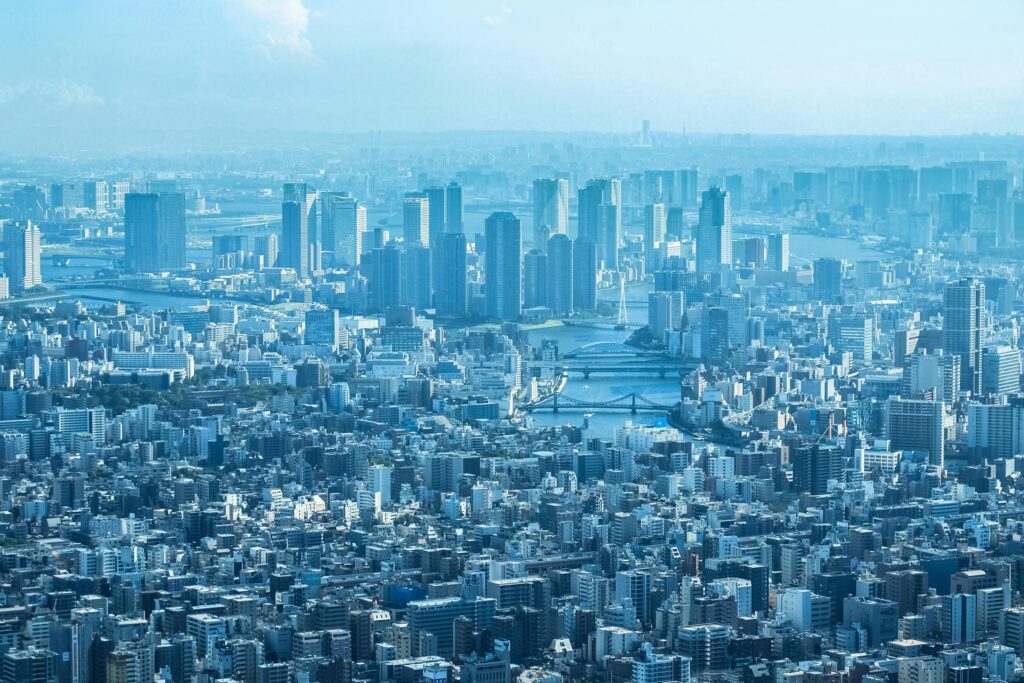The 12 Best Places to Visit in Seville
Seville, the vibrant capital of Spain’s Andalusia region, is a city that dances to the rhythm of its flamenco beats. Picture yourself wandering through narrow, winding streets adorned with colorful tiles and surrounded by buildings that showcase a mix of Moorish and Spanish architecture.
The city is a sensory delight, from the scent of orange blossoms in the air to the lively sounds of flamenco echoing through the streets. Seville is home to iconic landmarks like the Alcazar, a stunning palace with intricate Islamic design, and the Giralda Tower, which offers breathtaking views of the city.
Seville’s passion for life is palpable in its food as well. Indulge in tapas at local bars, where each bite is a burst of flavor. Whether you’re exploring the grandeur of the Cathedral or simply enjoying a siesta in a sun-drenched plaza, Seville captures the essence of Spain’s rich cultural tapestry.
These are the 12 best places to visit in Seville:
1. Seville Cathedral & La Giralda

The Seville Cathedral and La Giralda are two iconic landmarks in Seville, Spain, known for their rich history and stunning architecture.
The Seville Cathedral, officially known as the Cathedral of Saint Mary of the See, is the largest Gothic cathedral in the world. It was built on the site of a former mosque and was completed in the early 16th century. The cathedral’s interior is vast and adorned with numerous chapels, altars, and religious artifacts. One of its most famous features is the tomb of Christopher Columbus. The cathedral is a UNESCO World Heritage Site and is renowned for its grandeur and religious significance.
Adjacent to the cathedral is La Giralda, a bell tower that was originally constructed as a minaret during the Islamic rule of Spain. The tower is a stunning example of Mudéjar architecture, blending Islamic and Christian design elements. What sets La Giralda apart is its unique Renaissance addition—a large, elaborate Renaissance-style bell chamber at the top. Visitors can climb to the top of La Giralda for panoramic views of Seville, and the ascent is made easier by a series of ramps rather than stairs, a design feature influenced by the tower’s Islamic origins.
Together, the Seville Cathedral and La Giralda form a UNESCO-listed ensemble that reflects the city’s diverse cultural and architectural history. They stand as enduring symbols of Seville’s importance as a center of art, culture, and religion. If you ever find yourself in Seville, make sure to explore these landmarks—they’re a feast for the eyes and a journey through time!
2. Royal Alcázar of Seville
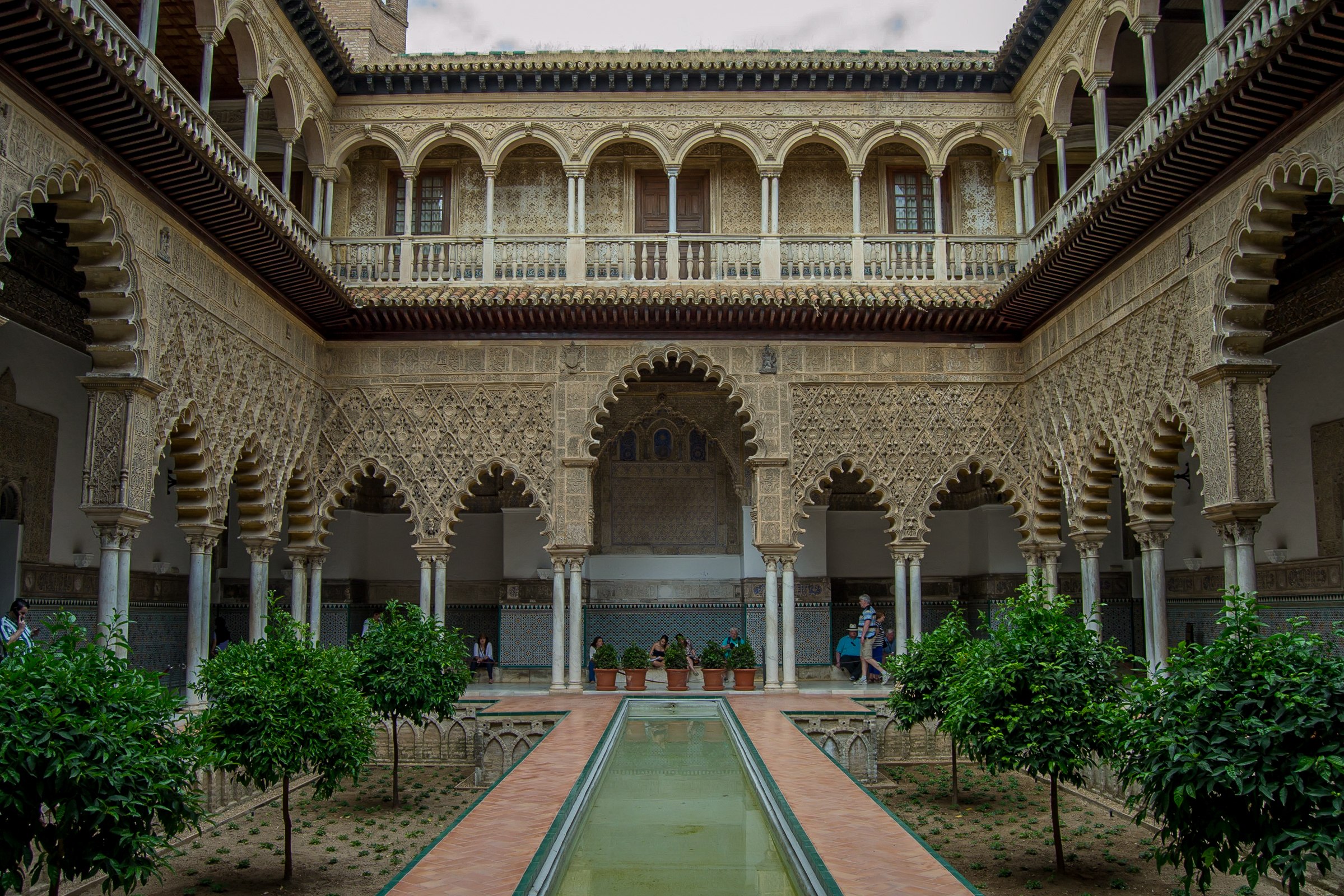
The Royal Alcázar of Seville is a stunning palace complex in the heart of Seville, Spain. With its origins dating back to the 10th century, the Alcázar has undergone various transformations, blending different architectural styles such as Moorish, Gothic, Renaissance, and Baroque.
The palace is a captivating maze of courtyards, halls, gardens, and opulent rooms, each telling a tale of its rich history. The intricate Mudéjar, Islamic, and Christian designs create a visual feast for visitors. The Patio de las Doncellas, with its exquisite azulejos (ceramic tiles), and the Hall of Ambassadors, a grand reception room, are just a glimpse of the architectural wonders within.
The lush gardens of the Alcázar are a peaceful retreat, adorned with fountains, orange trees, and vibrant flowers. The intricate detailing, coupled with the historical significance of the Royal Alcázar, makes it a must-visit destination for those enchanted by the splendors of Spanish history and architecture.
3. Plaza de España
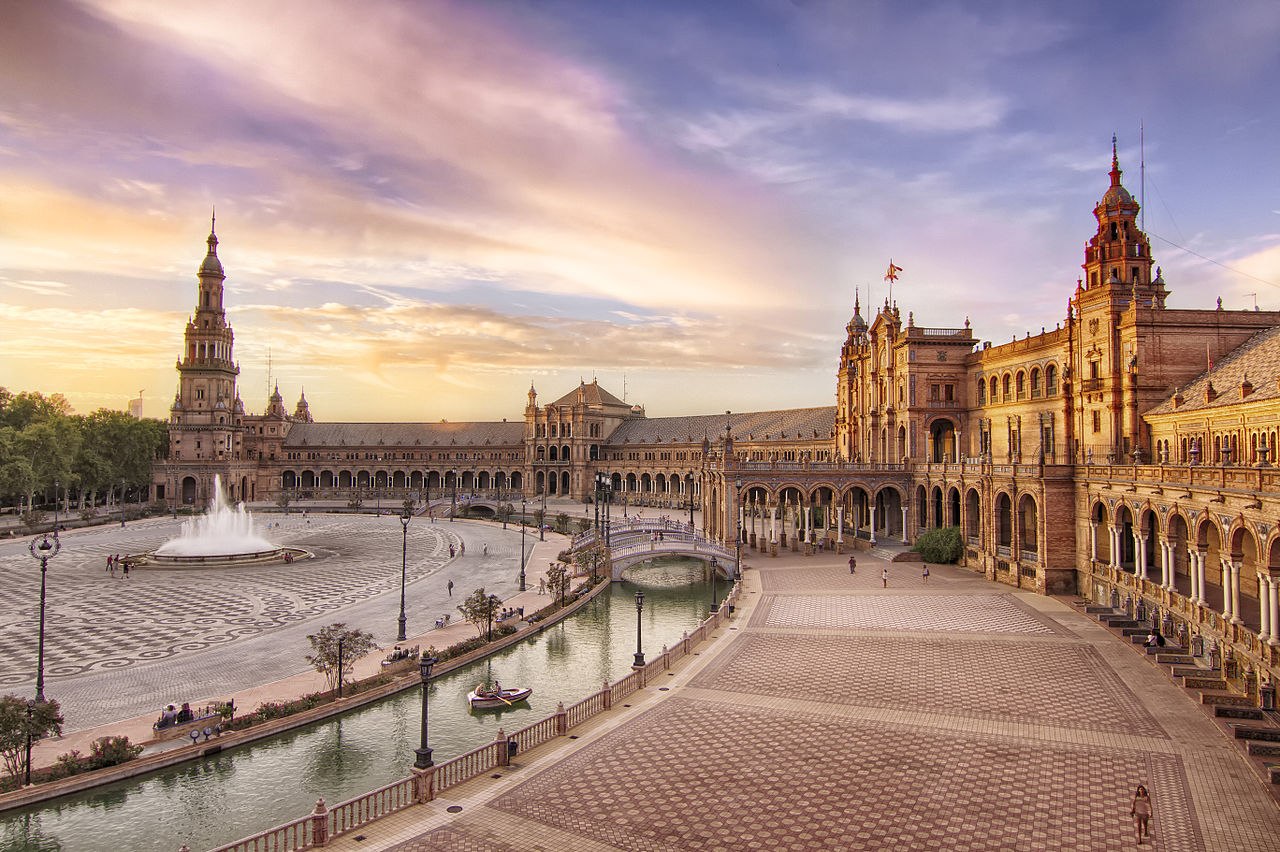
Plaza de España is a stunning square located in the heart of Seville, Spain. It’s a magnificent example of Spanish Renaissance Revival architecture and was built for the Ibero-American Exposition of 1929. The square is a semi-circular masterpiece with a central building that curves around it, creating a monumental effect.
At the center of the square, you’ll find a canal crossed by four bridges that represent the ancient kingdoms of Spain. The central building itself is adorned with colorful tiles, depicting historical scenes, and it’s flanked by two tall towers. The detailing is intricate and the overall design is a harmonious blend of Renaissance and Moorish styles.
Take a stroll around the plaza, and you’ll be greeted by a series of benches, alcoves, and ceramic-tiled alcoves representing different regions of Spain. The square is not just a feast for the eyes, it’s also a popular spot for locals and visitors alike to relax, enjoy the atmosphere, and take in the beauty of the surrounding architecture.
Overall, Plaza de España is a captivating architectural gem that not only serves as a testament to Spain’s rich history and culture but also provides a picturesque setting for leisure and appreciation. It’s a must-visit!
4. Metropol Parasol

Metropol Parasol is an architectural marvel located in the heart of Seville, Spain. Also known as “Las Setas”, it’s not your typical urban structure. Picture this: a series of massive wooden structures resembling giant mushrooms or parasols that stretch and twist against the Spanish sky. The design is both futuristic and organic, making it a standout piece in the historic city.
Completed in 2011, Metropol Parasol holds the title of the world’s largest wooden structure. The undulating parasols provide shade to the square below, creating a welcoming space for locals and visitors alike. Beneath the wooden canopy, you’ll find a vibrant market, shops, and restaurants—a perfect blend of modernity and tradition.
The structure’s interwoven lattice of wooden beams offers a unique perspective of the city, making it a favorite spot for panoramic views. Whether you’re into architecture, want to enjoy a stroll, or just fancy a coffee with a view, Metropol Parasol has got you covered—literally and figuratively.
5. Museum of Fine Arts

Seville’s Museum of Fine Arts, or Museo de Bellas Artes de Sevilla, is a cultural gem nestled in the heart of the city. Housed in a former convent, the museum showcases an impressive collection of Spanish art, spanning from the medieval period to the early 20th century.
As you enter, you’ll find yourself surrounded by masterpieces from renowned Spanish artists like Murillo, Velázquez, and Zurbarán. The museum’s rich collection also includes works from the Seville School of Painting, providing a comprehensive overview of the artistic evolution in the region.
The building itself is a work of art, featuring a cloistered courtyard and Baroque architecture that adds to the overall charm of the museum. Each room invites you to explore different periods of Spanish art history, offering a journey through time and artistic styles.
Whether you’re an art enthusiast or just a casual visitor, the Seville Museum of Fine Arts offers a captivating experience, providing insights into the cultural tapestry of Spain through the eyes of its talented artists.
6. Torre del Oro
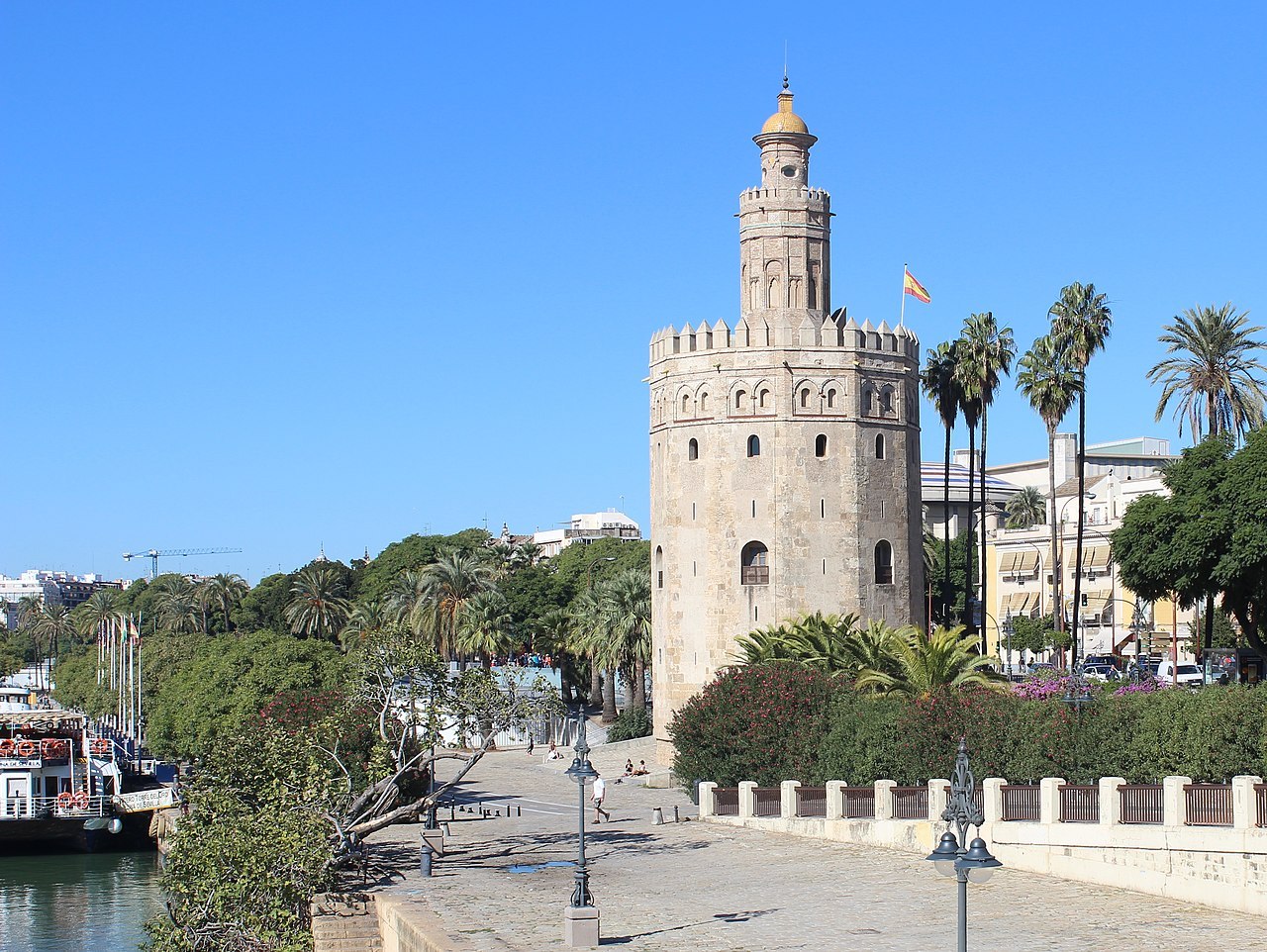
The Torre del Oro, or “Tower of Gold”, is a distinctive historical monument located in Seville, Spain. Standing on the banks of the Guadalquivir River, this iconic tower has been a part of the city’s skyline since the 13th century. Its name is believed to have originated from the golden glow the tower cast when the sun reflected off its original golden tiles.
The tower’s architecture is a fine example of military Moorish architecture, featuring twelve sides and three cylindrical sections. Originally constructed as a defensive watchtower during the Almohad dynasty, the Torre del Oro later served various purposes, including a prison and storage for precious metals and goods from the Americas during the colonial period.
Today, the Torre del Oro houses the Maritime Museum of Seville, offering visitors a chance to explore the city’s maritime history and discover artifacts related to navigation, trade, and shipbuilding. The tower itself remains a symbol of Seville’s rich past and a must-visit landmark for those exploring the historical treasures of this enchanting Spanish city.
7. Casa de Pilatos
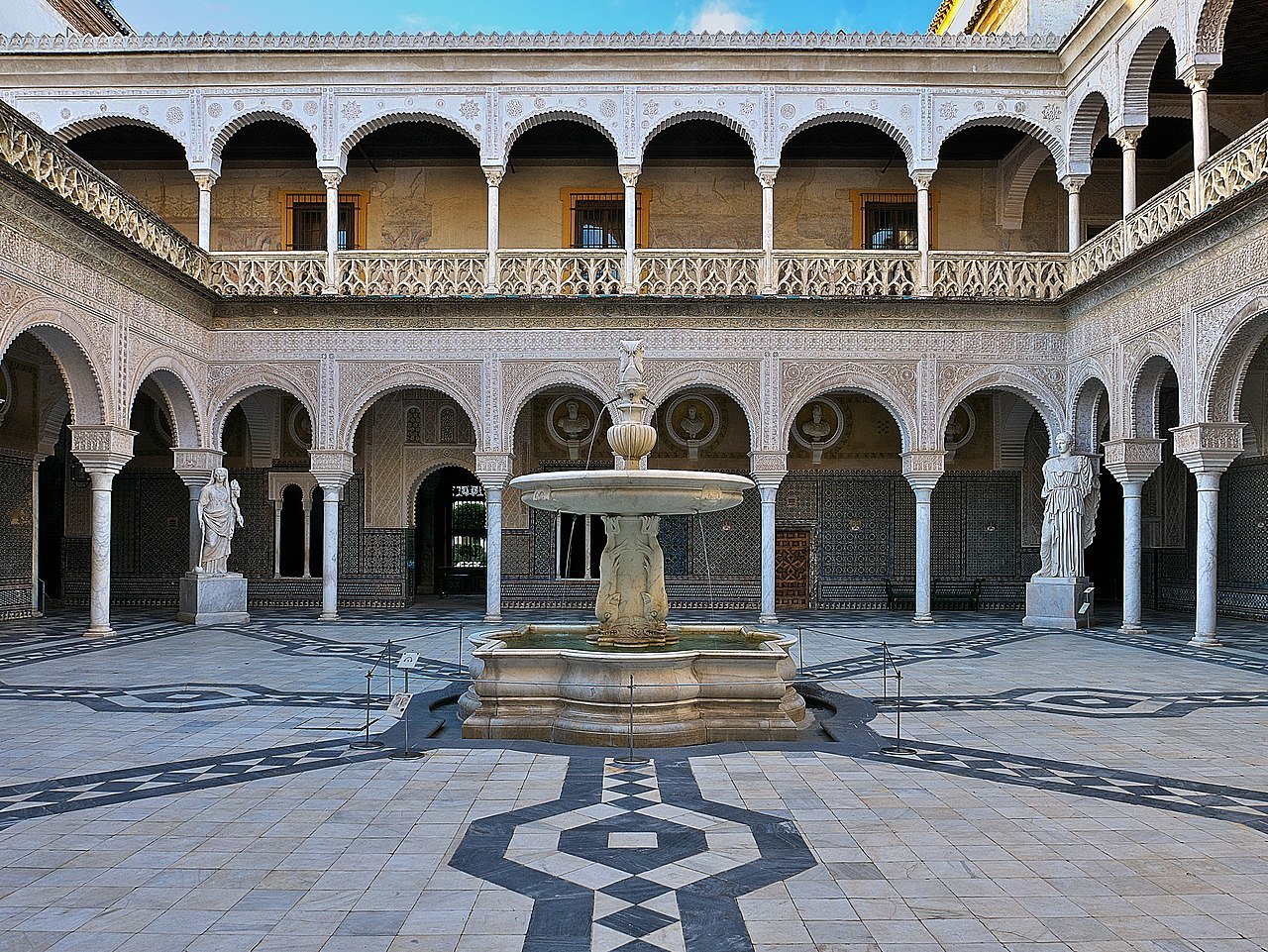
Casa de Pilatos in Seville is a stunning mansion that seamlessly fuses Mudéjar, Gothic, Renaissance, and Romantic architectural styles. Built in the 16th century, this palatial residence serves as a splendid example of Andalusian architecture. As you step into Casa de Pilatos, you’ll be greeted by a captivating courtyard adorned with marble columns, intricate tiles, and lush greenery. The mansion boasts a harmonious blend of different artistic and architectural influences, creating a unique and enchanting atmosphere.
The interiors of Casa de Pilatos are equally impressive, featuring ornate rooms with exquisite details such as coffered ceilings, decorative tiles, and intricate woodwork. Each room tells a story of the historical and cultural influences that shaped the mansion over the centuries. The palace is also known for its beautiful gardens, where you can wander among fountains, sculptures, and manicured greenery, providing a serene escape from the bustling city.
Casa de Pilatos is not just a historic site, it’s a living testament to the rich cultural heritage of Seville, inviting visitors to step back in time and immerse themselves in the opulence and charm of Andalusian architecture.
8. Santa Cruz Neighbourhood

Santa Cruz is like a living canvas that holds the rich history of Seville, Spain. This enchanting neighborhood, located in the heart of the city, was once the Jewish quarter during the medieval period. Wandering through its narrow cobblestone streets, you’ll find a labyrinth of whitewashed buildings adorned with vibrant bougainvillea and wrought-iron balconies.
The neighborhood is a captivating blend of Mudéjar, Gothic, and Renaissance architecture, each building telling a story of the past. As you meander through the winding alleys, you might stumble upon hidden squares, like the intimate Plaza de Santa Cruz, offering a peaceful retreat surrounded by orange trees.
Santa Cruz is also home to some of Seville’s most iconic landmarks, such as the stunning Seville Cathedral and the Royal Alcazar. The air is filled with the sweet scent of orange blossoms as you explore the intricate details of the neighborhood. It’s a place where time seems to slow down, inviting you to savor the charm of its historic streets, cozy tapas bars, and the warm hospitality of its residents. Whether you’re getting lost in its alleys or discovering a hidden courtyard, Santa Cruz is a journey through time, where every corner unveils a new chapter of Seville’s captivating past.
9. Triana Neighbourhood

Triana is a lively and charismatic neighborhood in Seville, Spain, situated on the west bank of the Guadalquivir River. Steeped in history and tradition, Triana has a distinct identity that sets it apart from the rest of the city. As you stroll through its narrow streets, you’ll encounter vibrant markets, traditional ceramic workshops, and picturesque squares.
One of the iconic landmarks in Triana is the Castillo de San Jorge, a medieval fortress that has witnessed centuries of Sevillian history. The neighborhood is also known for its connection to flamenco, with numerous tables and venues where you can experience the passionate and rhythmic dance form.
The Triana Bridge, officially known as the Puente de Isabel II, connects the neighborhood to the city center. Walking across this bridge provides stunning views of the river and the cityscape, especially during the sunset.
Triana is renowned for its culinary scene, offering a variety of tapas bars, and restaurants serving authentic Andalusian dishes. The lively atmosphere, combined with the warmth of the locals, makes Triana a must-visit destination for those looking to immerse themselves in the rich culture and traditions of Seville.
10. Palacio de las Dueñas
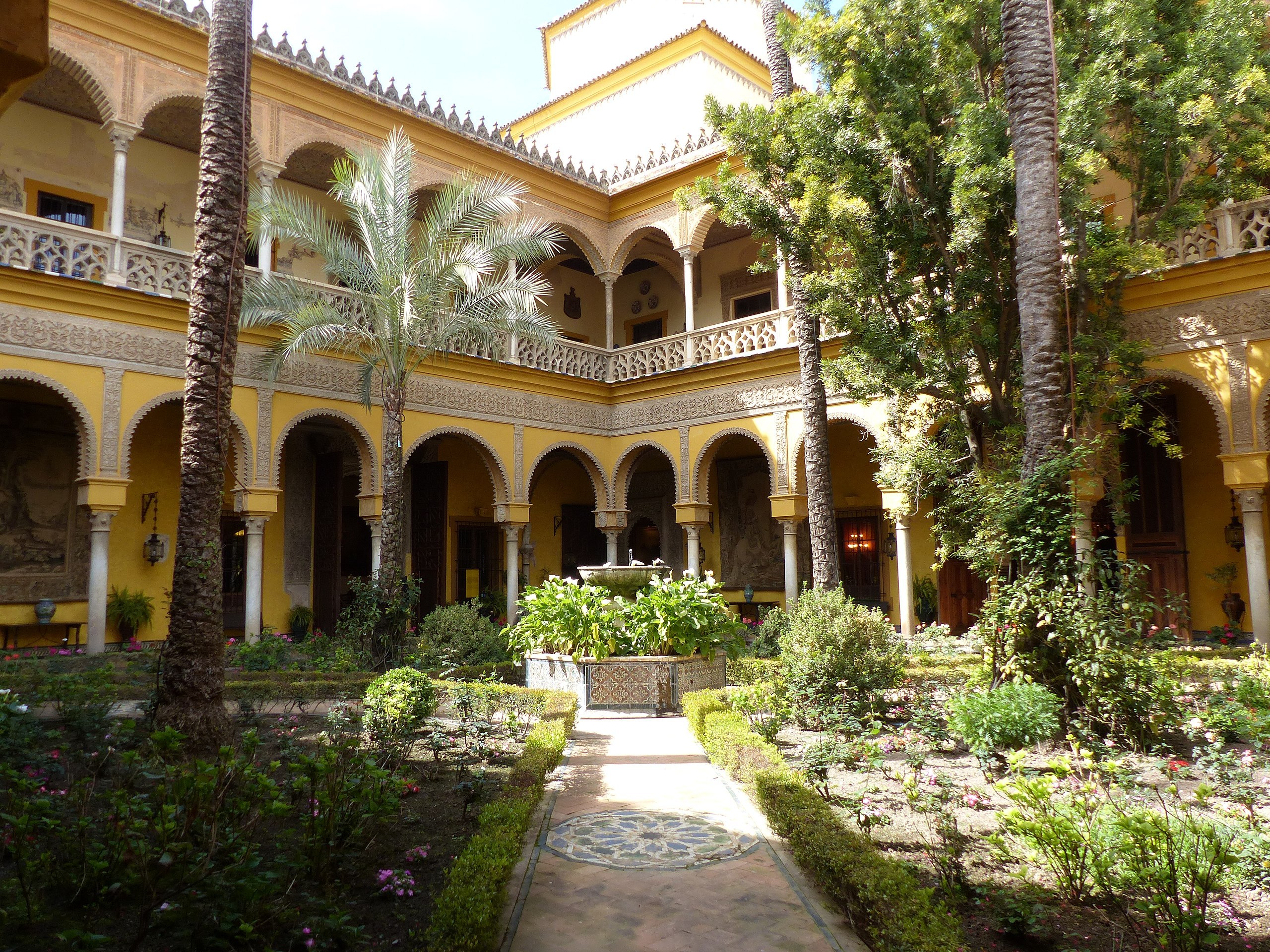
Palacio de las Dueñas is a magnificent palace in the heart of Seville, Spain, known for its rich history and stunning architecture. This grand residence, also referred to as the House of Dueñas, has a captivating mix of Gothic, Renaissance, and Mudéjar styles. The palace is surrounded by beautifully landscaped gardens, providing a tranquil escape from the bustling city.
As you enter the palace, you are greeted by a courtyard adorned with decorative tiles and lush greenery. The interiors are a testament to the opulence of Spanish nobility, with intricate detailing, ornate furniture, and an array of exquisite artworks. The rooms are filled with historical artifacts, reflecting the noble lineage of the palace.
One of the highlights of Palacio de las Dueñas is its connection to the renowned poet Antonio Machado, who lived here for a period. Visitors can explore the rooms where Machado worked, gaining insight into the literary history associated with the palace.
Wandering through the halls and gardens of Palacio de las Dueñas is like stepping back in time, allowing you to appreciate the cultural richness and architectural beauty that define this enchanting Sevillian landmark.
11. Archivo General de Indias

The Archivo General de Indias in Seville is a repository of immense historical significance. Established in the 18th century, the building itself is an architectural gem, located near the Cathedral and the Alcazar. This UNESCO World Heritage site houses an extensive collection of documents related to the Spanish colonies in the Americas and the Philippines, making it a vital resource for researchers and historians.
The archive’s building boasts a neoclassical design, with a symmetrical facade and a grand courtyard. Inside, visitors are surrounded by shelves upon shelves of meticulously cataloged manuscripts, maps, and records that offer insights into the exploration and colonization of the Americas. The wealth of information stored here provides a window into a pivotal period in world history, documenting the encounters between different cultures, the exchange of ideas, and the challenges faced by explorers and settlers.
For history enthusiasts and scholars, the Archivo General de Indias is a treasure trove, offering a tangible connection to the past and a deeper understanding of the complexities of colonial history. The significance of this archive extends beyond its walls, contributing to a broader appreciation of the cultural heritage shared between Spain and its former colonies.
12. Maria Luisa Park

Maria Luisa Park in Seville is a verdant oasis that enchants visitors with its lush greenery, beautiful gardens, and tranquil atmosphere. Named after Maria Luisa Fernanda de Bourbon, the park was donated to the city by the Duchess of Montpensier in the late 19th century. Covering a vast area along the Guadalquivir River, the park is a delightful blend of French and Moorish landscaping styles.
As you wander through Maria Luisa Park, you’ll encounter charming walkways, ornate bridges, and peaceful ponds. The Plaza de América, a square within the park, is surrounded by impressive buildings that showcase a mix of architectural styles. The park is also home to numerous fountains, statues, and flower beds, creating a picturesque setting for strolls or relaxing moments.
One of the park’s highlights is the Plaza de España, an iconic semicircular building adorned with colorful tiles, representing different regions of Spain. The combination of architectural beauty and natural splendor makes Maria Luisa Park a cherished retreat for both locals and tourists, providing a serene escape from the bustling energy of Seville.
Tips!
- See also: The 30 Best Cities to Visit in Spain: all of the best cities in Spain to visit!
Thank you for reading our blog post!





